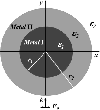Surface Plasmon Resonance from Bimetallic Interface in Au-Ag Core-Shell Structure Nanowires
- PMID: 20596451
- PMCID: PMC2893914
- DOI: 10.1007/s11671-009-9344-4
Surface Plasmon Resonance from Bimetallic Interface in Au-Ag Core-Shell Structure Nanowires
Abstract
Transverse surface plasmon resonances (SPR) in Au-Ag and Ag-Au core-shell structure nanowires have been investigated by means of quasi-static theory. There are two kinds of SPR bands resulting from the outer surface of wall metal and the interface between core and wall metals, respectively. The SPR corresponding to the interface, which is similar to that of alloy particle, decreases and shifts obviously with increasing the wall thickness. However, the SPR corresponding to the outer surface, which is similar to that of pure metal particle, increases and shifts slightly with increasing the wall thickness. A mechanism based on oscillatory surface electrons under coulombic attraction is developed to illuminate the shift fashion of SPR from bimetallic core-shell interface. The net charges and extra coulombic force in metallic wall affect the SPR energy and the shift fashion.
Figures




References
-
- Moskovits M, Srnova-Sloufova I, Vlckova B. J. 2002. p. 10436. - DOI
-
- Tsuji M, Matsuo R, Jiang P, Miyamae N, Ueyama D, Nishio M, Hikino S, Kumagae H, Kamarudin KSN, Tang XL. Cryst. 2008. p. 2529. - DOI
-
- Steinbruck A, Csaki A, Festag G, Fritzsche W. Plasmonics. 2006. p. 79. - DOI
-
- Mulvaney P, Giersig M, Henglein A. J. 1993. p. 7061. COI number [1:CAS:528:DyaK3sXktlOgsLo%3D] - DOI
-
- Han HF, Fang Y, Li ZP, Xu HX. Appl. 2008. p. 023116. Bibcode number [2008ApPhL..92b3116H] - DOI
LinkOut - more resources
Full Text Sources

